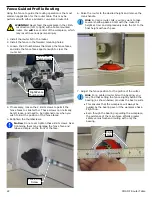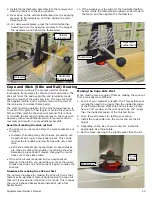
Supplemental Owner’s Manual
19
The miter fence may be placed on the miter head in either
the short profile or the tall profile positions.
7. Slide the miter fence over the clamping fingers in the
desired position and turn the clamping knob ¼-turn
either direction to lock it.
Clamping
Knob
Clamping
Fingers
Short
Profile
Tall
Profile
Clamping
Knob
Clamping
Fingers
8. Loosen the angle lock knob and lift the index pin to
change the angle of the miter gauge.
►
The index pin can be disabled by lifting it and then
turning it ¼-turn.
9. Loosen the extension lock knob and slide the miter
gauge forward or back as desired. (You’ll need to slide it
forward for the adjustment that follows.)
Extension
Lock Knob
Angle
Lock Knob
Index
Pin
Adjust the Sliding Rail and Table
1. Move the miter fence to the front of the sliding table,
and move the sliding table to the outfeed end of the
router table.
2.
Make sure the miter fence is in full contact with the slid-
ing table, but not touching the main table. If necessary,
raise the table as described in step 4
3. Examine the gap between the miter fence and the main
table. If the miter fence is not parallel with the main
table, adjust the pitch of the sliding table:
a.
Loosen the clamping screws for the front and rear
brackets under the sliding table.
b.
Tighten or loosen the adjustment screw until the
miter fence is parallel with the main table, and
retighten the clamping screws.
Adjustment
Screw
Clamping
Screw
4. Loosen the sliding rail’s mounting thumbscrew just
enough to allow the rail to move up and down.
5.
While sliding the table back and forth, tighten the
adjustment screw until the fence scrapes on the main
table.
6.
Unscrew the adjustment screw until the scraping stops.
Make sure to be pressing down slightly on the fence.
7. Retighten the mounting thumbscrew.
8.
Slide the table and miter fence to the infeed side of the
router table, and repeat the adjustment for the infeed
end of the sliding rail.
3mm
Hex Key
Mounting
Thumbscrew
Slight
Gap
Adjustment
Screw








































